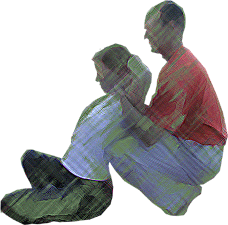Caution: The performance of pranayama is not a practice to be undertaken casually. There have been many reports of adverse reactions to the practice, and it is always recommended that pranayama be studied only under the guidance of a knowledgeable teacher. For example, people suffering physical ailments, such as high blood pressure, should never forcefully hold their breath. People with psychological problems are similarly advised to avoid the practice, unless being taught by an expert. Hopefully, it is obvious that pranayama is not something that can be learned from a book, or a Web page. Seek personal instruction wherever possible. For more information on precautions before practicing yoga, please check the Before You Practice section.
 In the chapter on the Energy Body we introduced the concept of Chi and prana. Energy, as we defined it in Western terms, is the ability to do work. In Eastern terms, energy is that which provides breath and life. That which provides life is pretty important – without life, the practice of Yin Yoga would not be of too much interest to anybody, and Yin Yoga teachers would be out of work. [1] How to nurture and enhance this life giving energy is worthy of study.
In the chapter on the Energy Body we introduced the concept of Chi and prana. Energy, as we defined it in Western terms, is the ability to do work. In Eastern terms, energy is that which provides breath and life. That which provides life is pretty important – without life, the practice of Yin Yoga would not be of too much interest to anybody, and Yin Yoga teachers would be out of work. [1] How to nurture and enhance this life giving energy is worthy of study.
Pranayama is the term often used to describe the practice of regulating our life force. However, pranayama is often used to describe regulating the prana flow by working with the breath. There are other ways to extend, and enhance, the flow of energy. Asana work itself stimulates energy flow. The Daoists invented similar movements as shown in Tai Chi, Qi Gong, and other practices. Massage does the same thing. In Thailand, a combined form of massage and yoga was developed out of the teachings of the Buddha. Thai Yoga Massage includes both practices in a very therapeutic way. In China, acupuncture and acupressure (which is also a form of massage) have been used for over two thousand years to stimulate Chi flow and remove blockages to its movement.
Just being with certain people can be beneficial for our energy body, while other people can be harmful to your energy health. Unfortunately, we have all experienced people who leave us feeling drained. Ancient masters have warned us to avoid those who are not good for us, and seek out enlightened company to benefit our energies. There are even ways to use our mind, our awareness, to enhance our energy body.
It is beyond the scope of our journey to visit all the myriad ways to free up, stimulate, and enhance energy. We will restrict our investigation to those methodologies most related to a Yin Yoga practice. Specifically we will cover:
Vinyasa gentle physical movement to regulate energy
Pranayama regulating energy through the breath
Meditation harnessing the mind to regulate energy
There is no best time to do energy work. Even though pranayama follows asana in the eight-limbed (ashtanga) methodology of the Yoga Sutra, this was not meant to say that we must do asana before pranayama, nor that we must do pranayama before meditation. These were called limbs (angas) for a reason. Just as limbs of a tree are not ordered in any sequence, it is possible to do any of these limbs at any time. It is always a question of what your objective is.
In the Yin Yoga practice, you may choose to stimulate the flow of energy at the beginning of a class, so that when we remove blockages to the flow, the energy can move right away. However, in this case, we may want to choose a way to free up the flow that will not overly warm up the muscles. Mild vinyasa work, or some forms of pranayama, would be good ways to move energy prior to the asana practice. We can equally attempt to move the energy while we are in the poses, or between poses. We could use other pranayama techniques, meditation, or brief yang vinyasas at these times. At the end of an asana practice, meditation is wonderful, but again some forms of pranayama are also excellent for bringing balance back to the body after the long yin emphasis.
There are many options – be creative. Try different ways to move energy and try at different times. See what works best for your body, but please respect the caution at the beginning of this section. Remember that you can do too much of anything. You can overdo a yin practice and become lethargic; you can overdo a yang practice and become exhausted; you can overdo energy development and suffer burnout and other traumas. If you plan to experiment with some of the procedures, go slowly and observe the results carefully. If you start to feel uncomfortable for any reason, stop. If you have any health concerns, do see your health care professional before beginning any energy work.
(Next: Vinyasa )
